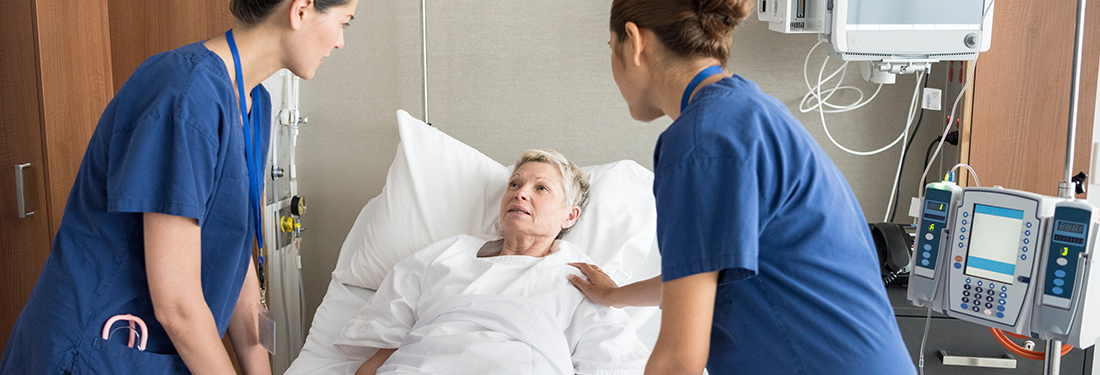Empowering teams to identify and address sepsis, in under one hour
Virginia Mason staff members share their experiences implementing the Sepsis Power Hour protocol
Sepsis is a factor in one out of every two to three hospital deaths in the United States1, killing 258,000 patients annually, and is the most costly condition for hospitals to treat. When sepsis occurs, each hour matters, and even an hour delay significantly jeopardizes patient survival. Tackling the barriers to quickly provide critical care to patients with sepsis is a top priority for health care organizations today.
Virginia Mason has spent over five years applying process improvement work to create a new approach to delivering faster, higher quality care to patients suffering sepsis. Delays in treatment were identified and addressed, and best practices were created, tested, and refined. The resulting solution empowers teams to achieve the early recognition of sepsis and administer rapid interventions.
“The best thing about Sepsis Power Hour is that it brings care to the patient without the patient having to wait; it really leverages the whole multidisciplinary team exactly where their skills and strengths are, and the ultimate beneficiary is the patient.”
– Alice Ferguson
According to nurse project manager, Alice Ferguson, “The best thing about Sepsis Power Hour is that it brings care to the patient without the patient having to wait; it really leverages the whole multidisciplinary team exactly where their skills and strengths are, and the ultimate beneficiary is the patient.”
The outcomes of implementing this protocol at Virginia Mason have proven to greatly reduce the costs associated with the treatment of sepsis, as well as, dramatically improve patient outcomes. The high success rate of implementing the bundle on-time at Virginia Mason, in less than one hour, has led to lower pharmacy costs associated with sepsis treatments, reduced the number of days patients spend in the hospital, and decreased mortality rates due to sepsis.
The average cost of treating a 90-day episode of sepsis at Virginia Mason is 21.5 percent less than the national average, and discharges to long-term care facilities has been reduced by 15 percent. Calls to the Rapid Response Team at Virginia Mason have declined by 66 percent from 120 calls per month to 40.
Expanding implementation to overlooked medical units
To address the issue further, Virginia Mason introduced the Sepsis Power Hour within the medical surgery department. Medical surgical units are left out of most sepsis training and implementation plans, however, data shows these patients are at the greatest risk of sepsis advancing once present. Also, it is not uncommon for seemingly healthier patients to get triaged to medical surgical units where their sepsis progresses unrecognized into severe sepsis or septic shock.
“I can think of two answers why a focus on medical surgery units is especially important – The population of patients who develop sepsis while on a medical surgery floor is a relatively small population when you look at all sepsis within a hospital, but that population has a much higher risk of not surviving during their hospitalization – their mortality rate is higher, so it’s a critical group to recognize and treat,” relayed hospitalist, Evan Coates, MD. “Secondly, with acute stroke patients or acute coronary syndrome – all those types of problems in general – you’re going to get faster treatment if you develop the problem at home, call 911, and are brought to the ER than you would get if you’re already on our hospital floor, and that’s not a Virginia Mason issue, that’s the way it is at most hospitals in the U.S. That’s why Sepsis Power Hour was important to me, it’s about getting our patients who are already in the hospital the same level of care they could get if they walked into our ER.”
“That’s why Sepsis Power Hour was important to me, it’s about getting our patients who are already in the hospital the same level of care they could get if they walked into our ER.”
– Evan Coates, MD
Providing exactly the right care, in the exact right moment
A patient-first culture at Virginia Mason, and the tools to work in flow, supported the development and implementation of the sepsis bundle to provide maximum benefits to the patient. This is an example of where wasteful activities were eliminated to create greater skill-task alignment, so all members of the patient’s health care team are more empowered and better equipped to provide exactly the right care, at the exact right moment.
“I’ve seen patients do dramatically better with the implementation of Sepsis Power Hour. I’ve seen doctors responding faster to sepsis, I’ve seen nurses are more directed, they can give more effective treatments in the span of time that it takes to notify and page doctors. I’ve also seen patients react better, they’re more at ease when they see nurses and doctors more directed and what they’re doing – they feel more confident and their families are more put at ease, I think, when it’s been done,” described patient care technician, Jaryd Kiyabu.
The nurse especially plays a critical role, and is responsible for initiating the Sepsis Power Hour after recognizing signs of sepsis or after being alerted by a nursing assistant. This assignment is designed to allow screening measures to occur faster, and for each step of treatment to be delivered as quickly as possible, directly to the patient, without waits or delays that could seriously threaten their outcome. The protocol is a rapid infusion of fluids, a broad spectrum antibiotics, blood cultures are drawn, and lactate are drawn – but the real goal is to complete it all within an hour.
Each member of the care team serves a critical role to more rapidly identify symptoms and execute care for the patient; the nursing assistant, the nurse, the phlebotomist, the pharmacy, the physician, and the project manager. Together, a trained and coordinated health care team can greatly reduce the time it takes to identify and treat sepsis to improve outcomes and reduce the overwhelming costs associated with sepsis at hospitals across the world.
“What has really changed with patients and families is in the numbers. Our mortality rate has been decreasing year after year for four years straight. Our rapid-response call rate has reduced from 120 a month to 40 a month. It’s in the numbers – care is better for patients,” says Coates.





